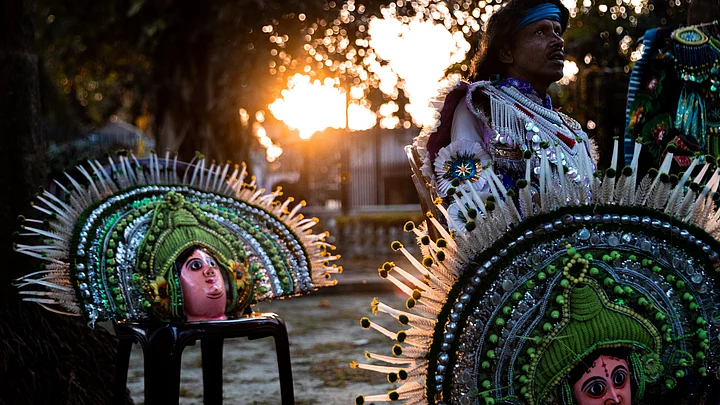Artists, when they take to the stage are putting up an act. They are performing, being someone other than themselves. But what about when they aren't? Who are they just before they take the stage?
This is a question that The Quint set out to answer as it documented folk artists in their intimate spaces as they prepare to perform.
The West Bengal Tourism department in association with Banglanatak dot com held a three day 'Folk Safar' in Kolkata from February 18-20.
The event aimed at showcasing folk music, dance and art from different corners of the state, especially rural Bengal which is known for its rich folk culture. It also aimed at promoting artists who have been severely affected by the COVID induced lockdown.
The event saw performances ranging from Purulia's famous Chhau dance to the Jhumur dance from the Sundarbans, and music performances like the famous Baul music.
Chhau Dance
The Chhau dance which originated in eastern India and has its roots in Purulia enacts episodes from epics and local folklores. It is connected to regional rituals, specifically the spring festival of Chaitra Parva.
Local folklore primarily revolves around gods and goddess slaying the evil demon and saving the world, and thus most of the masks depict known goddesses like Durga and her avatars and some of the demons who she fought.
The dance form involves wearing of huge masks and the performers indulging in mock combat.
The Quint followed Binadhar Kumar and his group, who hail from Purulia's Bamnia as they performed at the event.
Traditionally the dance used to be performed by men only, but with time, women too have taken it up.
Jhumur and Natua Dance
The Jhumur dance is a tribal dance which originated in the tea tribe communities of Assam. This dance is performed by both men and women to the rhythm of the Madal.
As the name suggests, the Jhumur or the Jhoomar is an important part of the perforamce and all the women performing wear a pair.
The dance signifies ritual worship, specifically in the autumn season. It also signifies or celebrates courtship.
The Quint documented Bablu Sardar and his group Tusu Mata Sampraday, who come from Satjelia in the Sundarbans. The reporter also followed Biren Kalindi's Cho dance troop who performed not only the Chhau and Jhumur dance, but also the Natua dance.
The Natua dance is a form of dance drama and is usually performed during marriages or other special occassions. It is often signified by the lead dancer having tribal patterns drawn all over his body with clay.
Baul Music
Baul's are famous all across India and are an ancient group of vagabonds who would go place to place busking. They have had a significant influence throughout history not only in Bengal's music but also its culture.
(At The Quint, we question everything. Play an active role in shaping our journalism by becoming a member today.)
